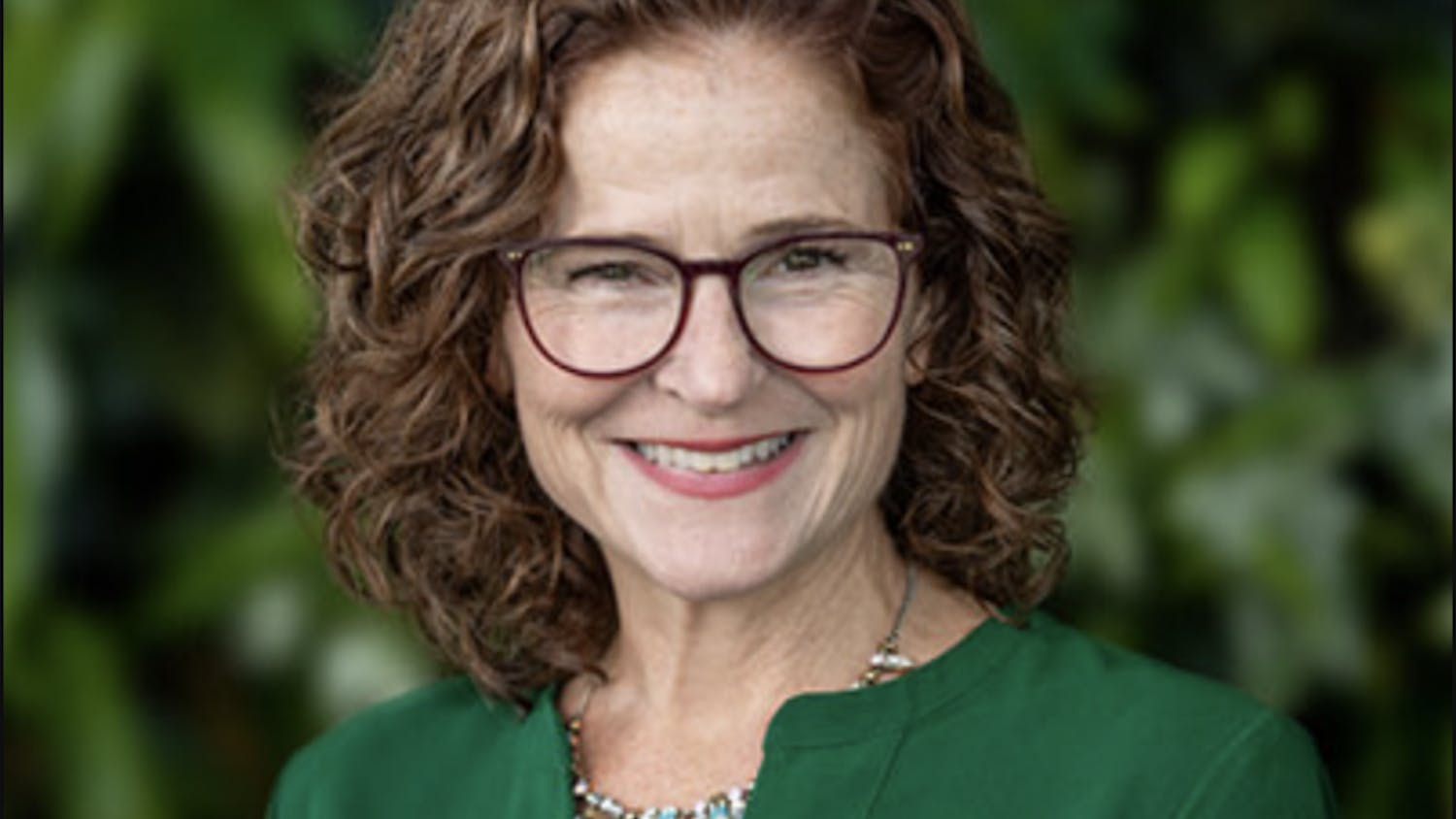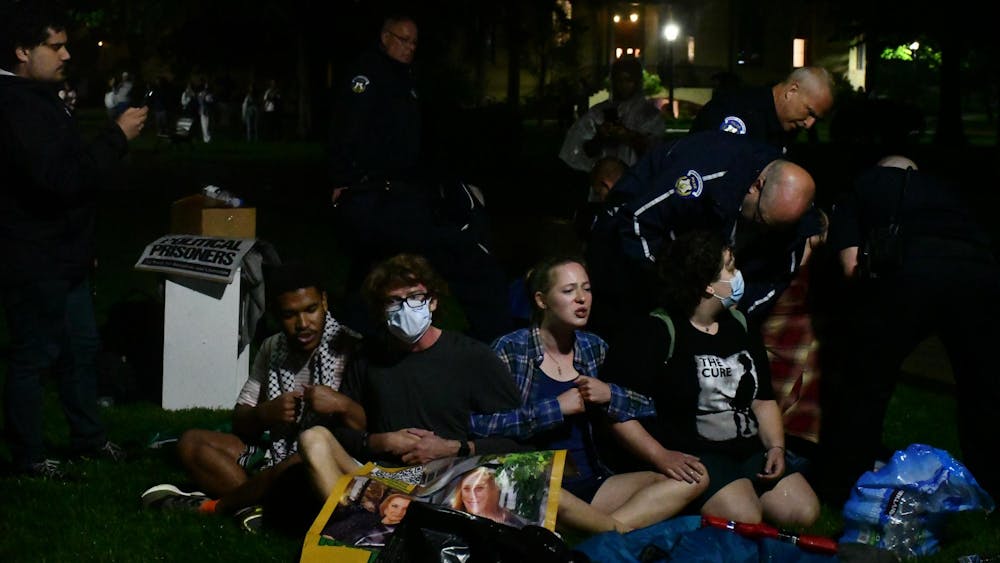According to legend, when Holy Roman Emperor Otto III entered the tomb of Charlemagne in the early 11th century, he found the great medieval king’s personal copy of the four gospels, written with gold ink on purple pages, complete with paintings of the four gospel writers. Recently, the Hesburgh Library purchased a facsimile of the gospels for $22,000. The facsimile, held in the Rare Book room, is an exact copy of the original Coronation Gospels, made for Charlemagne in the early ninth century A.D. The original manuscript currently resides in the Imperial Treasury in Vienna, Austria.
Marina Smyth, the medieval studies librarian who organized the funds to buy the facsimile, said it was “probably the most expensive purchase [she’s] been responsible for.”
She said the library’s existing collection of 43 Carolingian facsimiles, or material dating from 800-900 A.D., motivated her to acquire the copy of the manuscript. The manuscript was made by Swiss publisher Faksimile Verlag, she said.
“The way it happens is, I look at this thing, and I say, hmm, this would be a good thing to have,” Smyth said. “One of my pieces of reasoning would be, we actually already have a very strong collection of facsimiles of Carolingian material.
“We also have two professors who specialize in Carolingian stuff — history, and then there’s an art historian who would be very interested in this.”
Smyth said she raised $11,000 from the history, art and theology departments, the Medieval Institute and two medieval studies endowed collections. The other $11,000, she said, came from the library’s Special Acquisitions Fund, a competitive grant process. She said she ordered the facimile by Nov. 14 and it arrived in mid-February.
“What I like about it is that it’s kind of is a crown on a very fine collection of facsimiles of Carolingian manuscripts that we have,” Smyth said.
According to visiting paleography professor David Ganz, the original manuscript is important because it represents a rediscovery of a classical painting style, a recognition of the Gospel writers as historical figures. He said its purple pages and gold script denote the work of an extremely skilled scribe.
He said the value of Notre Dame’s facsimile lies in how exactly it resembles the original manuscript, down to the holes in the page and the flakes in the paint.
“The fact that the pages aren’t all the same size shows how carefully [the facsimile was made], and you can see the fold in the skin being reproduced — that’s what happens to the poor unfortunate cow on whom this was written,” Ganz said.
Ganz said the original manuscript, because it has a sculpted gold cover, is inaccessible to most scholars. The facsimile, which Ganz said is one of three in the United States, will be used as a research and teaching tool. It is accessible to all students and faculty.
“It’s not bought to sit in the Rare Book Room on the shelves,” Ganz said. “Just like the Dante collection, just like the Robert Creeley collection, it’s there for people to study, and therefore, from now on, everybody taking an art history course may have the chance to see it.”
The facsimile, held in the Rare Book room, is an exact copy of the original Coronation Gospels, made for Charlemagne in the early ninth century A.D. The original manuscript currently resides in the Imperial Treasury in Vienna, Austria.
Marina Smyth, the medieval studies librarian who organized the funds to buy the facsimile, said it was “probably the most expensive purchase [she’s] been responsible for.”
She said the library’s existing collection of 43 Carolingian facsimiles, or material dating from 800-900 A.D., motivated her to acquire the copy of the manuscript. The manuscript was made by Swiss publisher Faksimile Verlag, she said.
“The way it happens is, I look at this thing, and I say, hmm, this would be a good thing to have,” Smyth said. “One of my pieces of reasoning would be, we actually already have a very strong collection of facsimiles of Carolingian material.
“We also have two professors who specialize in Carolingian stuff — history, and then there’s an art historian who would be very interested in this.”
Smyth said she raised $11,000 from the history, art and theology departments, the Medieval Institute and two medieval studies endowed collections. The other $11,000, she said, came from the library’s Special Acquisitions Fund, a competitive grant process. She said she ordered the facimile by Nov. 14 and it arrived in mid-February.
“What I like about it is that it’s kind of is a crown on a very fine collection of facsimiles of Carolingian manuscripts that we have,” Smyth said.
According to visiting paleography professor David Ganz, the original manuscript is important because it represents a rediscovery of a classical painting style, a recognition of the Gospel writers as historical figures. He said its purple pages and gold script denote the work of an extremely skilled scribe.
He said the value of Notre Dame’s facsimile lies in how exactly it resembles the original manuscript, down to the holes in the page and the flakes in the paint.
“The fact that the pages aren’t all the same size shows how carefully [the facsimile was made], and you can see the fold in the skin being reproduced — that’s what happens to the poor unfortunate cow on whom this was written,” Ganz said.
Ganz said the original manuscript, because it has a sculpted gold cover, is inaccessible to most scholars. The facsimile, which Ganz said is one of three in the United States, will be used as a research and teaching tool. It is accessible to all students and faculty.
“It’s not bought to sit in the Rare Book Room on the shelves,” Ganz said. “Just like the Dante collection, just like the Robert Creeley collection, it’s there for people to study, and therefore, from now on, everybody taking an art history course may have the chance to see it.”













